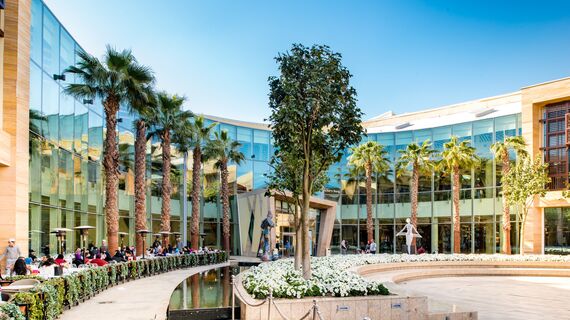- Reza Daneshmir
- Catherine Spiridonoff
Mellat Park cineplex
Cinema is one of Iran’s most popular art forms. Since the Islamic Revolution in 1979, the medium of film has developed steadily and become increasingly significant in the field of cultural production. The Mellat Park Cineplex in Tehran, designed by the Iranian architects Catherine Spiridonoff and Reza Daneshmir, is a project that gives expression to this development and also adds to the still surprisingly small number of cinema screens in the cities of Iran.
Situated at the south-west end of Mellat Park, one of the largest of about 800 parks in Tehran, this new cinema complex blends almost organically into the landscape. Surrounded by the park on the north and east sides, the building is adjacent to the multi-lane Niayesh Highway to the south and a sports complex to the west. The 15,000 m² of total floor area accomodates four cinema screens, each of which can be viewed by 300 visitors, plus a small projection room for up to 40 people, exhibition spaces, a restaurant, coffee shop, CD and book shop, offices and service units. The complex can serve a maximum of 2,200 visitors during peak periods. The long shape of the site and the space allocation plan resulted in a long, curved building, which interacts with its environment due to its structure. There are two facing cinema screens on the ground floor and basement. On both floors, the two cinemas are interconnected in order to take advantage of the gradient particular to cinema halls and create a large vaulted area on each floor below a curve connecting the two screens. On the ground floor, this makes the building accessible, while also acting as a spacious covered entrance area. The basement benefits from the same amount of space, which is used as an exhibition area. In the same way, a further open area has been created on the upper floor, in which the restaurant is located. These three horizontal, open areas are connected by two vertical volumes at both ends of the building, which house the cinema foyers and service units.
Fluid transition
The entrance hall is one of the central motifs of this architecture. Neither outdoor nor indoor, it creates a fluid transition between the park and the inside of the complex. On the north side, ramps climb up the park paths and guide visitors towards the building. Due to the curved shape of the building, the width of the individual sections varies, which gave rise to a curved route when the ramp system was designed. This brings it closer to its actual topological location within the park and supports the idea of a fluid transition between the inside and outside. The support system is made from steel and concrete and designed to make all construction elements visible. The materials that form the curved inner walls are partially textured. The horizontal surfaces are clad with artificial coloured stone slabs, with one colour per storey. Steel plates are used on the façade, the vertical columns on the ends of the building and the suspended ceilings, which were prepared using a special manual process.
Transparency
The glass façade gives the building an understated elegance and opens the building up to the park due to its transparency, while at the same time creating a link with the outside on this level. The subtle design of the CW 50 façade system from Reynaers Aluminium blends excellently into the design and highlights the light character of the building. During the installation, a specially made connecting piece was used to mount the glass surface to the pipe. This innovation enabled the use of the standard intermediate bracket. The BS 100 sun screening system fits perfectly into the façade system and also emphasises the horizontal façade structure. In addition, for this project, a special solution was developed, which enables the louvres to be adjusted to the desired angle. Both Reynaers systems used in this project not only proved their flexibility and ability to adapt to non-standard situations, roadening the range of the system’s possible applications, they also contributed greatly to one of the main characteristics of this building – its transparency.
Used systems
Involved stakeholders
Architect
- Reza Daneshmir
- Catherine Spiridonoff
Fabricator
- Fan Avar Bana Tacim
Photographer
- Ali Daghigh
- Afsin Ghaderpanah
Other stakeholder
- Nikan Niroo Co. (Investors)








